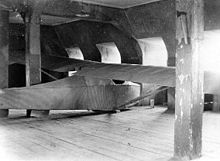Colditz Glider
The Colditz Glider , also " Colditz Cock " (from English Cock , German Hahn), was a glider constructed by prisoners of war , which was to serve in 1945 to escape from the prison camp at Colditz Castle .
idea
The idea of escaping with a glider came from the two pilots Jack Best and Bill Goldfinch , who had been brought to the heavily guarded Colditz Castle after trying to escape from other POW camps. The inspiration for this was given by the two newcomers Tony Rolt , a well-known British racing driver before the war, a Formula 1 driver after the war , and David Walker.
Rolt recommended the roof of the castle chapel with the tables mounted on it as a launch pad, as this would keep the intention a secret from the Germans until the launch. The plan was to make a two-man glider in individual parts and put it together just before take-off. The escapees wanted to cross the Zwickau Mulde by plane and land on a meadow approx. 60 m lower.
construction
The glider was assembled by Bill Goldfinch and Jack Best in a well-camouflaged part of the attic above the chapel, separated by an additional partition. Since the Germans were looking for tunnels and did not suspect a secret workshop under the roof, the builders felt safe. Even so, they used observers and an electrical warning system to prevent detection.
The glider was slowly being built from stolen pieces of wood. The wing spars were made from floorboards, hundreds of ribs from bed slats. Electrical wiring from unused parts of the lock was used for the control cables.
Welsh prisoner Lorne Welch , who was a glider expert, was asked to check the pressure graphs and calculations made by Goldfinch. The constructed glider was a light two-seat high- wing aircraft . It had a mooney control and square elevator . The wingspan was 9.75 m and the length between nose and tail was 6 m. Cotton duvet covers from the prison with a blue and white check pattern were used to cover the wings. Cooked millet from the prisoner's rations was used to seal the pores of the cloth. With the materials used, a construction weight of 109 kilograms was achieved. However, it was not until after the Liberation of Colditz that the plane was assembled to be photographed by American troops.
begin
In view of the soon-to-be-expected end of the war, the prisoners only considered the dangerous start in an emergency, such as the takeover of the camp by the SS .
The start was to take place as a catapult launch with a cable system from a ramp made up of tables on the roof of the castle chapel. A fully loaded metal bathtub falling on the outer wall should guarantee the necessary acceleration to 50 km / h. A replica of the Colditzer glider was made in 2000 for the TV documentary Escape from Colditz by Channel 4 (Great Britain). Under the eyes of Colditz veterans Jack Best and Bill Goldfinch, the aircraft actually flew successfully on its first attempt at take-off. It is currently on display at the Imperial War Museum in London.
media
- Channel 4 (GB) 3-part TV documentary (150 minutes) Escape from Colditz
- A cage full of heroes
Web links
- Detailed information
- 55 years later, the replica successfully flew
- Colditz glider (replica of Flugwelt Altenburg-Nobitz eV) in the MHM Gatow - Link to Museum-Digital (German)
Coordinates: 51 ° 7 ′ 53 ″ N , 12 ° 48 ′ 26 ″ E

